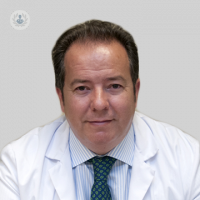aneurysm
Written by:What is an aneurysm?
Aneurysm is a segmental dilation of an artery in the body. We can say that the classic degenerative aneurysm is of unknown cause, except those that are related to specific pathologies such as fungal or infectious aneurysm, cerebral aneurysm , those that are secondary to some rheumatological diseases and vasculitis. It is known that some alteration in the arterial wall causes it to weaken and may progressively expand, reaching diameters higher than usual. We can speak of aneurysm when the artery exceeds 50% its normal size.
Where can it appear?
The aneurysm can develop in any artery of the body, although Angiologists and Vascular Surgeons are accustomed to certain frequent locations, such as the abdominal and thoracoabdominal aorta, the iliac artery, the femoral artery and the popliteal artery.. There are less frequent aneurysms of other arteries such as the visceral and renal arteries, those of supra-aortic trunks, those of an upper limb or those of distal arteries of the lower limbs.. We can affirm that the usual and most known aneurysm by the population is the Anerusima de Aorta , known as triple A ( AAA ).
Are there risk factors?
The final cause that causes an aneurysm, especially the aortic aneurysm, is unknown, but we can talk about risk factors. Age is one of them; as it is a slow-growing pathology, AAAs in children under 50 are almost non-existent. It is from the age of 60 that the population prevalence increases progressively. Gender is another factor, given that it is between 5 and 10 times more frequent in males.
Other risk factors are smoking and chronic obstructive pulmonary disease, hypertension, family history of aneurysm, coronary heart disease, MMII atherosclerosis obliterans, hypercholesterolemia, Marfan syndrome, or Ehlers-Danlos syndrome.
Can it be prevented?
We can not prevent AAA, but we can do early detection in patients with risk factors. An aortic echodoppler allows us to determine in most cases the diameter of the artery with enough accuracy. In fact, many aortic aneurysms are discovered in abdominal ultrasounds performed for another reason.
What symptoms does it cause?
In many cases it is a pathology without symptoms that goes unnoticed. This is a problem because in many cases it is not detected until it causes its greatest complication, the rupture of the artery, with a very high mortality. Hence the importance of early detection. The rupture is closely related to the size of the aortic aneurysm (especially after 5 cm) and its rate of growth (especially if it grows 0.5 cm in 6 months).
In some patients a pulsating abdominal mass is visible. AAA can cause abdominal or lumbar pain, either by itself or by compression of neighboring structures. Rarely, part of the thrombus that is usually formed in the wall of the aneurysm may be detached and cause an embolism as the first symptom.
How can it be treated?
Ideally, surgical repair before the AAA can give complications. Today we have two options, and it is important that the Vascular Surgeon dominates both to offer the best treatment in each case. We will choose the best option according to the anatomical characteristics of the aneurysm and its extension, the risk factors of the patient or the existence of previous surgeries.
The first option is open classic surgery , where the diseased aorta is replaced by a prosthesis. Although it is a classic technique, it has evolved a lot in recent years benefiting from surgical and anesthetic improvements. The second option is endovascular surgery , newer and less aggressive, which aims to exclude the circulation of the dilated aorta area by placing prostheses that are released after navigating through the arteries.
In general, conventional surgery is more aggressive but more resolutive, while the endovascular option is less aggressive but less definitive.. The important thing is that the vascular surgeon, in consensus with the patient, choose the most appropriate option in each case.




